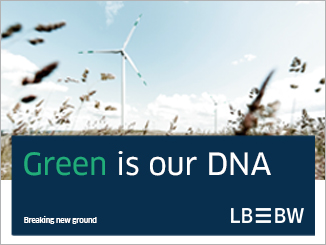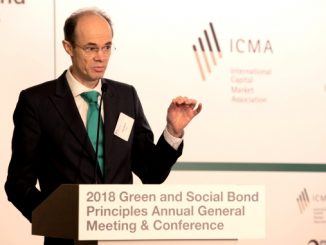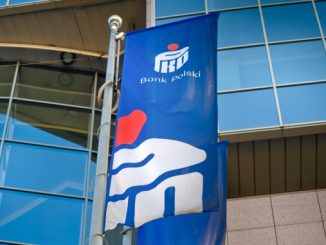
A year on from SpareBank 1 Østlandet’s green bond debut, Karoline Bakka Hjertø, head of sustainability, and Runar Hauge, portfolio manager, treasury, spoke to Sustainabonds’ Neil Day about how the bank is furthering its ESG ambitions. Eivind Hegelstad, CFO and investor relations, SpareBank 1 Boligkreditt — the SpareBank 1 banks’ joint covered bond-issuing specialist entity — joined the pair to share insights into green mortgages and the related funding strategy.
You can download a pdf version of this article here.
Neil Day, Sustainabonds: What does sustainability mean for SpareBank 1 Østlandet overall?
Karoline Bakka Hjertø, SpareBank 1 Østlandet: Following the merger that created SpareBank 1 Østlandet (SPOL) in 2017, sustainability was included as one of the six strategic ambitions of the bank. That in itself shows that we put sustainability absolutely at the core of our business.
 Beneath that, we set two goals. One is, with all the tools that we have at our disposal within the bank, to help our customers in the transition we know they have to go through. The other goal is simply implementing sustainability in everything that we do. Within the latter, we have around 50 sub-goals — everything from how we run our buildings, to procurement, to diversity, and so on — such that sustainability is implemented across the whole bank in policies, strategies and action plans. This, in turn, provides a foundation for our most important target of working with our customers.
Beneath that, we set two goals. One is, with all the tools that we have at our disposal within the bank, to help our customers in the transition we know they have to go through. The other goal is simply implementing sustainability in everything that we do. Within the latter, we have around 50 sub-goals — everything from how we run our buildings, to procurement, to diversity, and so on — such that sustainability is implemented across the whole bank in policies, strategies and action plans. This, in turn, provides a foundation for our most important target of working with our customers.
We have mostly been engaging with our corporate clients on this front, because the world needs industries to go through the transition, but we have also been working with private customers more and more.
Day, Sustainabonds: How is sustainability embedded in the bank’s governance?
Hjertø, SPOL: We try to integrate sustainability into the structure of the bank in the same way that we would any other topic, so we embed it into all policies, roles and responsibilities, instead of looking at it as a side issue. This means, for example, that the person responsible for sustainability work regarding the corporate market is the director responsible for the corporate market. But since sustainability is a developing topic for the bank, and since it’s also relevant to look at sustainability in an interlinked manner — for example, how procurement goes together with the work we do towards our customers — we have a sustainability board comprising the most strategically-placed relevant roles, working on sustainability in the different departments in the bank. It functions more like an advisory board for the group management, seeking to inform what is happening from one division to another. We’re quite a large organisation by Norwegian standards, so it’s helpful to be able to have an overview of everything we do.
Day, Sustainabonds: Which sustainability initiatives does the bank participate in and why?
Hjertø, SPOL: We find the UNEP FI initiatives very relevant for the bank. We have been part of the Principles for Responsible Banking since the beginning, have actively used them, and were actually involved in the group that developed the impact analysis. We were an early signatory of the Collective Commitment on Climate Action, which has developed further into the Net Zero Banking Alliance (and, in turn, the Glasgow Financial Alliance for Net Zero, GFANZ), and are now one of just two Norwegian banks that are members of that alliance.
We find these groups extremely useful, because we have a dialogue with banks from all over the world, on methods, how to set targets, how to measure — all the nitty-gritty details that have to be in place to be able to set targets and to report coherently in our sector. And we are of course reporting accordingly with those initiatives. We also report according to the TCFD, using the OECD guidelines, to CDP; we are part of the Coalition for Responsible Business in Norway, using the Global Reporting Initiative; and we have been Eco-Lighthouse certified since 2008.
Another initiative to mention is the Partnership for Carbon Accounting Financials (PCAF), which we’ve also been using quite extensively in reporting on emissions from our corporate portfolio. To reiterate, without a common methodology and common data, it’s impossible to compare numbers between actors, between banks. So we are very fond of these international collaborations where we try to do things the same way.
I was also involved in establishing the Norwegian network of the Global Compact from 2017. This is a valuable initiative in providing a common platform across industries and government.
Day, Sustainabonds: How are you going about measuring Scope 1, 2 and 3 emissions? And what targets have you set?
Hjertø, SPOL: We are measuring our own Scope 1, Scope 2, and Scope 3 emissions, using the Eco-Lighthouse framework. That has provided us with comparability for many years. We have also set a science-based target (SBT) and are reporting on progress and reduction targets within the different sources of emissions.
When it comes to Scope 3, we already in 2019 started reporting on emissions in our lending portfolio. That is despite the challenges when it comes to data, accuracy, and all of that, because we think it’s important to show that we’re going in this direction. We know it’s not perfect, we know you do not have all the data — particularly given that we have a lot of SMEs, where it’s difficult to both get hold of data and to make estimations. But in spite of that, we chose to report Scope 3 in our corporate lending portfolio already back in 2019. And then, during 2020, we started using the PCAF, which gives us a better methodology and also enables comparability — the more banks that are using the PCAF methodology, the more banks you can compare numbers for.
We have also set a simplified science-based target in our annual report for the corporate portfolio, showing our stakeholders how we aim to be net zero in 2050. We believe we need to improve year by year, with better data, better methodologies, and more accurate reporting. But you can’t sit and wait for the perfect before starting, because you’ll never find the perfect way of reporting a lot of data in sustainability. So in our annual report from 2020, page 233, you can see our projected emissions and our path towards net zero for all the sectors in the corporate lending portfolio. In our annual report 2021, we will report on sub-sectors and also publish an SBT for our mortgage portfolio.
Day, Sustainabonds: Are ESG factors evaluated in the credit decisions you make in respect of companies? Are there activities that are excluded?
Hjertø, SPOL: We are not engaged in fossil industries in Norway — so not coal, oil or gas — and not nuclear power — that’s not because we’re necessarily against all of it, but it’s not one of the sectors we have. And not mining. Then we have exclusion policies when it comes, for example, to timber from illegal logging, large scale dam projects, tobacco, pornographic material, etc.
Regarding the other question, we have a sort of ladder approach when it comes to our corporate customers. The first step is the exclusion policies, the sectors we choose not to be involved in in the first place.
The second step is ESG assessments, which is a sort of due diligence on all loans over NOK1m (€98k). This is quite a low threshold and therefore covers almost all corporate loans. The ESG assessment is quite extensive, with questions covering climate risk, nature risk, social issues such as labour rights and human rights, and governance. This assessment has two purposes. One is to find the activities that in our view have too much climate or other ESG risk, and which we will not want to be part of. The other is to use them to help our customers in their transition. We discuss with them the issues that are facing their sector, point them towards what can be done, and encourage them to move in that direction.
Then on top of that we have our green loan products.
Day, Sustainabonds: That’s my next question: what incentives do you offer clients to take a green approach?
Hjertø, SPOL: We are working on this continuously. Right now, we have green agricultural loans with favourable interest rates and favourable car loans, while on the mortgage side, we have a green mortgage loan and an energy efficiency mortgage loan for energy efficient activities in your home. Those are the products that we currently have, and we are looking to expand on this.
Day, Sustainabonds: In your green bond presentation from last February, you cited some targets for green lending — can you provide an update on those?
Hjertø, SPOL: That’s a good question and I’m eager to see the numbers, but as they are in respect of 2021, I’m currently waiting for the results from the relevant departments, and they will be in our annual report. For some of them, we have faced issues in finding the relevant certifications.
We are now revising all our sustainability targets across the bank because we are at the end of this current strategy. In these discussions, both the retail department and the corporate department have been saying that the targets need to be revised every year because there is so much happening in the sustainability world. Things are moving so fast these days that goals we thought were ambitious two years ago are already outdated. We may therefore need to tighten them more often in certain areas.
Day, Sustainabonds: How did you go about choosing which categories of loans to include in the green bond framework?
Runar Hauge, SpareBank 1 Østlandet: One thing that sets us a little apart from the other Norwegian savings banks is that we are landlocked. Geographically, we are positioned towards the Swedish border and don’t have any coastline to speak of, so we don’t have exposure to offshore industries like oil, gas and fisheries — for better or for worse. On the ESG side, that’s probably for the better.
 When we started working on the green bond framework, we looked at our lending portfolio, and what’s clear is that real estate and residential mortgages are a large part of the balance. 74% of the total lending including loans transferred to SpareBank 1 Boligkreditt (SpaBol) is residential mortgages. In addition, 12% is commercial real estate. And so when looking at the green bond framework, green residential and commercial buildings are, of course, a large part of the eligible volumes and an important use-of-proceeds category.
When we started working on the green bond framework, we looked at our lending portfolio, and what’s clear is that real estate and residential mortgages are a large part of the balance. 74% of the total lending including loans transferred to SpareBank 1 Boligkreditt (SpaBol) is residential mortgages. In addition, 12% is commercial real estate. And so when looking at the green bond framework, green residential and commercial buildings are, of course, a large part of the eligible volumes and an important use-of-proceeds category.
We also have renewable energy, small-scale power plants, and clean transportations, which in practice is electrical vehicles — we have seen really high growth in that category. In addition, we are in rural areas, meaning that forestry and agriculture constitute the dominant part of the corporate portfolio, so we have included that as well. The volumes are not too large so far, but we have set quite high thresholds for inclusion — forestry is quite good, but we haven’t any agriculture assets in it yet. Reaching the appropriate thresholds is a challenge for the whole business and agriculture is on the difficult side. We will have to see how the taxonomy lands there, particularly given that that the criteria for agriculture were delayed.
The total volume so far is NOK18.7bn, which is actually growth of 11% for the first nine months of 2021.

Day, Sustainabonds: How do you go about deciding which assets you will use for your own green bond issuance, and which you will transfer to SpaBol for green covered bond issuance?
Hauge, SPOL: SpareBank 1 Østlandet is the largest owner of SpaBol. We have a target of how much we will transfer to SpaBol overall and we try to mirror that in the green share that we transfer. But for us it is also a question of diversification of funding. In February last year we issued our inaugural senior preferred green bond, a €500m seven year, and we had a really good book. A great benefit of that was that we reached pockets of investors that hadn’t previously been involved in our issuance. We also observed that we have more greenium in senior preferred — although that may of course change. So we will try to be supportive of both covered and senior preferred going forward.
Eivind Hegelstad, SpareBank 1 Boligkreditt: On that point, it’s important to note that although the SpareBank 1 Alliance banks may transfer green mortgages to SpaBol, it’s just a way of funding the mortgages. Clearly that has implications for reporting on the energy efficiency of the respective portfolios — we can’t report CO2 savings twice, for example, only one entity can do that. But everything that we have funded for SPOL belongs to SPOL, and I think it’s important to bear that in mind. So when you look at the banks’ market share of green lending, for example, this should also include any mortgages that have been transferred to SpaBol.
Hauge, SPOL: Definitely. Whether or not we use covered — also on the green side — is foremost a funding decision, and we will also report on the green share that is with SpaBol.
Day, Sustainabonds: What are the criteria for mortgages to qualify as green in SpaBol’s covered bond issuance?
Hegelstad, SpaBol: When we started looking into this, we looked for a definition of what is green, and we used the Climate Bond Initiative’s definition — which is also now applicable in the EU taxonomy — namely that the top 15% most energy efficient housing in every local market belongs to the green category. And that’s exactly where we started. Then it’s a question of looking at how many residential properties in your country or in your market are labelled A and B, and maybe C, and whether this is more or less than 15%.
The problem we then had was that the labelling is insufficient. We have a law on the books that says every house sold or constructed from 1 January 2010 needs to have a label, but it’s still lacking. There are big holes in the data registry. So we looked at building codes instead, at the most recently built properties, and came up with a formula a few years ago. When we started the work in 2017 and issued the first green covered bond in 2018, we had a cut-off whereby anything built from January 2009 onward belonged to the green category, being able to demonstrate that the building year was a proxy for the energy label, and that the properties covered were less than 15% of the overall Norwegian market. We monitored that carefully and in 2021 tightened eligibility such that we now include anything built from 2012 onward. We grandfathered the properties included under the previous criteria, but do not accept into the green bond portfolio any further properties that do not meet the updated date.

Day, Sustainabonds: That covers existing buildings and the relevant taxonomy criteria. But what is the situation when it comes to new builds? How satisfactory is the taxonomy?
Hegelstad, SpaBol: It’s a work in progress. Under the Energy Performance of Buildings Directive, EU countries have to develop near zero energy building (NZEB) codes. I’ve seen that a lot of countries have basically refreshed their latest building codes, maybe with a bit of tightening here and there, and called them NZEBs, which could be a fair approach. There’s some work being done on that in Norway, too, and we will have an NZEB code at some point, but we don’t have it yet. And that’s the first issue when trying to meet the EU Taxonomy requirement for new builds: you don’t know exactly what it is.

The second challenge is that the taxonomy says you have to be 10% better than that code on an energy efficiency basis. The first question is, why? Yes, you do have some households and construction companies who are thinking about building passive houses, and based on gut feeling they could meet the definition of being 10% more energy efficient than required by the building code. But I doubt most construction will. So we have to do some work with our consultants, Multiconsult — who are a green mortgage verifier for the Climate Bonds Initiative — to see how we get there in practice. Could it be that an A hangs so high on the Norwegian scale that it is actually 10% or more better than what is expected under the NZEB code? Or both A and B? That’s where we have to make some assessments to see how we can move forward and build the volume of such green mortgages for new builds from 2021 onward.
At the same time — and this is the task of SPOL and the other Alliance banks — customers have to be incentivised. That is done by offering mortgage rate discounts, building more green houses, and adding to homes elements that reduces energy consumption so they become more energy efficient and thereby also perhaps achieve a green mortgage. We adopted a broad swath approach to get some volume into the green bonds, but there are a lot of specific things you can do to make buildings more efficient and potentially eligible for a green mortgage. I’m thinking about one of these for myself: putting integrated solar roof tiles on my roof to produce my own electricity. My house is just outside the regular definition for green at the moment, but such a step could mean that it qualifies as green, and then I could get a green mortgage on it. Banks must incentivise customers to do these types of things, and they are absolutely engaged in that.
Day, Sustainabonds: The taxonomy is relevant beyond green bonds and banks are faced with the European Banking Authority’s incoming Green Asset Ratio. To what extent are these initiatives a challenge for SPOL more broadly?
Hjertø, SPOL: Eivind just discussed the NZEB, which is a common challenge for banks in Norway as well as the EU.
As a savings bank, almost all our corporate lending is to SMEs, and their inclusion is an issue for us. We want to report on this lending, but how and when to get data from them is a challenge.
It’s going to be important for us to have a dialogue with them and explain the relevance of the taxonomy and other incoming regulations, even if they do not have to report at the moment, because the aim behind the taxonomy is to move capital from grey to green — looking at the reason for the legislation is as important for them as looking at just the concrete obligations. Everything is moving in the same direction and it is in their interest to act.
Day, Sustainabonds: What can we expect from SpaBol and SPOL in terms of green bond issuance this year?
Hegelstad, SpaBol: I think we will issue another green covered bond this year, later in the year. We did indeed issue a conventional covered bond today (13 January). That’s just a function of Sparebank 1 now being the largest banking group in Norway by market share in the residential market, on the back of organic growth and two smaller banks having joined in the past year and a half. We are larger now than DNB. That means we finance a great deal of mortgages that aren’t green — we can’t exclude people — and so there will of course be more conventional covered bonds than green covered bonds, based on the top 15% criteria. But we’re working on gathering sufficient collateral and there should be another green covered bond this year. I’m not sure which currency that will come in, it could be euros like the conventional one today, or pounds, or perhaps Swedish kronor, where we’ve issued a green bond before.
Hauge, SPOL: And SpareBank 1 Østlandet is also planning another green senior preferred in euros, probably during first half this year.
Sustainabonds conducts all research and writing independently to maintain the full editorial integrity of the publication.
As a supporter of Sustainabonds, LBBW is facilitating a series of interviews with leading players in ESG and the green, social and sustainability bond markets.




